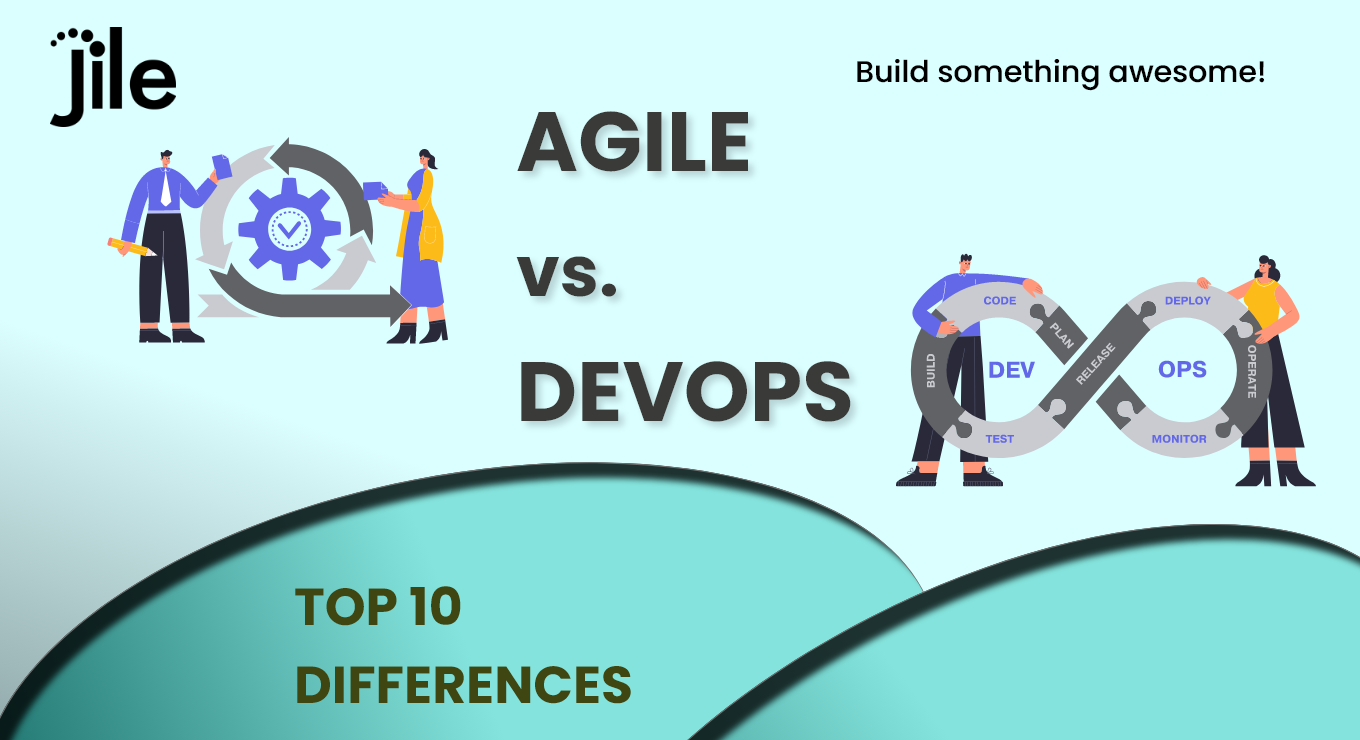Agile vs. DevOps: Top Differences You Should Know

A range of techniques and elements involved in software development makes it a diverse domain. Agile and DevOps are two of those most common concepts in the industry these days. The purpose of both methods is similar - deploying the end product as efficiently and quickly as possible. Here we are going to discuss all about Agile vs. DevOps software development methodologies.
What is Agile methodology?
While many companies are keen to use these methodologies, there is still some confusion between the two. You might have been thinking about what is the difference between Agile and DevOps methodologies, and which one is the best for proper execution, or why do you need them?
In this blog, we will shed light on DevOps vs. Agile.
What is Agile?
Agile methodology focuses on the simultaneous and iterative approach during the software development process. Thus, continuous iterations, as well as testing, are feasible in the Software Development Life cycle (SDLC). As a result, development cycles become short, highly efficient, and bugs, and potential feature, and functionality-related challenges are addressed on the go, making agile developers become more efficient.
What is DevOps?
DevOps methodology is a bridge between the operations team and the software development process. Through uninterrupted integrations, communication, and collaboration between siloed IT teams, DevOps helps improve the productivity and delivery speed of products in an automated way.
Agile Methodology vs. DevOps
Agile and DevOps practices comprise the culture and set of strategies to attain agility, faster delivery, enhanced security, and better service. Check out the major differences between Agile and DevOps processes.
a.) Intention
The main purpose of the Agile methodology is the effective management of complex projects. Its iterative approach allows better collaboration and ensures product development as per customer feedback with rapid releases. Besides, this process focuses on quality based on changes asked by the customers.
Performing end-to-end development processes of the ready-to-release product to deploy it securely is the primary objective of DevOps. This process ensures software quality through early bug removal, automation, and a robust deployment environment.
b.) Task
To achieve optimum results, Agile continuously switches from one task to another. The core actions under this task include Requirement, Design, Development, Testing, Debugging, and Maintenance phases.
Unlike Agile, DevOps concentrates on constant software testing and delivery with no glitches. The core actions under this task include Process, Requirement, Design, Engineering, Development, Test, Debug, Deployment, and Maintenance phases.
c.) Practice
During Agile practice, teams only develop and launch software without any deployment. On the contrary, DevOps uses pre-built software to securely release and perform software deployment.
d.) Speed of Production
The Agile methodology focuses on incremental deployments after each sprint. Generally, it takes a week or two to complete.
Constant daily delivery is possible with the DevOps methodology. This process can even complete within a few hours.
e.) Team Skill Set
For the Agile process, an organization must hire highly proficient people of similar skill sets to perform the tasks effortlessly.
On the other hand, organizations need to hire employees with different functional skills and specializations for successful DevOps operations. It helps achieve the best results by breaking down and efficiently distributing responsibilities.
f.) Team Size
The Agile process needs a small team, wherein members can work closely for risk reduction and more rapid execution.
Due to the team integration approach, DevOps requires a bigger team with multiple departments.
g.) Scheduling
Agile methodology offers flexibility to lower-level tasks. Since each "release" is developed during one or more set units called "sprints," it lasts merely a week.
DevOps has a long-term schedule because it focuses on reliabilities, decreasing business disruptions.
h.) Shortcomings
Teams need to be more productive while performing the Agile process.
Whereas, to streamline work, the DevOps method needs better testing, development, and production environments.
Advantages - Agile and DevOps
Here are the key takeaways, highlighting the advantages of implementing both methodologies to develop products without any loopholes.
Advantages of Agile
- Better defect detection for faster software delivery
- Prompt change and a robust structure
- A scope of release every 1 or 2 weeks
- Satisfied customers
Advantages of DevOps
- Removes the communication gap between IT operations and software development teams
- Shares feedback proactively to support a structured DevOps pipeline
- Reduces the effect of poor documentation and enhances efficiency during software deployment through automation
- Lessens the management and production costs for various departments
Disadvantages - Agile and DevOps
Similarly, let's delve into some shortcomings of both software development practices.
Disadvantages of Agile
- No attention after deployment of the product
- Difficult to predict the time, cost, and resources required initially
- Incremental delivery isn't adequate for long-term projects
Disadvantages of DevOps
- No commonly accepted framework
- Complex communication due to separate development and operational teams
- Difficult to handle legacy system
Summary
Agile methodology vs. DevOps, which one are you leaning towards? It essentially depends on your specific business, and product development needs, the objectives that you wish to achieve - from customer experience to product development efficiency to greater business ROI. Agile is the widely leveraged SDLC by organizations due to its efficiency in delivering quality products, improved UX, and fast deliverability.
However, organizations also understand the importance of DevOps methodology. It stands successfully due to continuous testing, collaboration, development, and deployment practices. Thus, organizations must look into the key Agile and DevOps differences and other key aspects prior to making any decision.
While Agile and DevOps practices complement each other, DevOps acts as an extension to Agile. DevOps focuses on benchmarks and deadlines more, but Agile functions in sprints. So, when integrated with DevOps practices, Agile can bridge the gap in the software production cycle. Thus, there is no need to adopt one methodology over another. Both these methodologies can coexist, and businesses can stand to gain cumulative advantages.
Undoubtedly, Agile and DevOps can work in tandem during software development and deployment processes. Hence, organizations must ensure a mix of both methods to boost efficiency.
Thanks for subscribing to our latest blogs, thought leadership and other product updates!
Read our Privacy Notice to know more. You can opt-out of all communications anytime.
